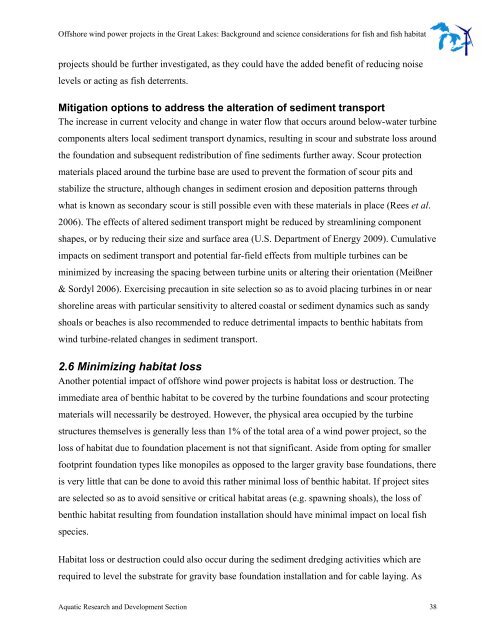Offshore Wind Power Projects in the Great Lakes - Ministry of ...
Offshore Wind Power Projects in the Great Lakes - Ministry of ...
Offshore Wind Power Projects in the Great Lakes - Ministry of ...
Create successful ePaper yourself
Turn your PDF publications into a flip-book with our unique Google optimized e-Paper software.
<strong>Offshore</strong> w<strong>in</strong>d power projects <strong>in</strong> <strong>the</strong> <strong>Great</strong> <strong>Lakes</strong>: Background and science considerations for fish and fish habitat<br />
projects should be fur<strong>the</strong>r <strong>in</strong>vestigated, as <strong>the</strong>y could have <strong>the</strong> added benefit <strong>of</strong> reduc<strong>in</strong>g noise<br />
levels or act<strong>in</strong>g as fish deterrents.<br />
Mitigation options to address <strong>the</strong> alteration <strong>of</strong> sediment transport<br />
The <strong>in</strong>crease <strong>in</strong> current velocity and change <strong>in</strong> water flow that occurs around below-water turb<strong>in</strong>e<br />
components alters local sediment transport dynamics, result<strong>in</strong>g <strong>in</strong> scour and substrate loss around<br />
<strong>the</strong> foundation and subsequent redistribution <strong>of</strong> f<strong>in</strong>e sediments fur<strong>the</strong>r away. Scour protection<br />
materials placed around <strong>the</strong> turb<strong>in</strong>e base are used to prevent <strong>the</strong> formation <strong>of</strong> scour pits and<br />
stabilize <strong>the</strong> structure, although changes <strong>in</strong> sediment erosion and deposition patterns through<br />
what is known as secondary scour is still possible even with <strong>the</strong>se materials <strong>in</strong> place (Rees et al.<br />
2006). The effects <strong>of</strong> altered sediment transport might be reduced by streaml<strong>in</strong><strong>in</strong>g component<br />
shapes, or by reduc<strong>in</strong>g <strong>the</strong>ir size and surface area (U.S. Department <strong>of</strong> Energy 2009). Cumulative<br />
impacts on sediment transport and potential far-field effects from multiple turb<strong>in</strong>es can be<br />
m<strong>in</strong>imized by <strong>in</strong>creas<strong>in</strong>g <strong>the</strong> spac<strong>in</strong>g between turb<strong>in</strong>e units or alter<strong>in</strong>g <strong>the</strong>ir orientation (Meißner<br />
& Sordyl 2006). Exercis<strong>in</strong>g precaution <strong>in</strong> site selection so as to avoid plac<strong>in</strong>g turb<strong>in</strong>es <strong>in</strong> or near<br />
shorel<strong>in</strong>e areas with particular sensitivity to altered coastal or sediment dynamics such as sandy<br />
shoals or beaches is also recommended to reduce detrimental impacts to benthic habitats from<br />
w<strong>in</strong>d turb<strong>in</strong>e-related changes <strong>in</strong> sediment transport.<br />
2.6 M<strong>in</strong>imiz<strong>in</strong>g habitat loss<br />
Ano<strong>the</strong>r potential impact <strong>of</strong> <strong>of</strong>fshore w<strong>in</strong>d power projects is habitat loss or destruction. The<br />
immediate area <strong>of</strong> benthic habitat to be covered by <strong>the</strong> turb<strong>in</strong>e foundations and scour protect<strong>in</strong>g<br />
materials will necessarily be destroyed. However, <strong>the</strong> physical area occupied by <strong>the</strong> turb<strong>in</strong>e<br />
structures <strong>the</strong>mselves is generally less than 1% <strong>of</strong> <strong>the</strong> total area <strong>of</strong> a w<strong>in</strong>d power project, so <strong>the</strong><br />
loss <strong>of</strong> habitat due to foundation placement is not that significant. Aside from opt<strong>in</strong>g for smaller<br />
footpr<strong>in</strong>t foundation types like monopiles as opposed to <strong>the</strong> larger gravity base foundations, <strong>the</strong>re<br />
is very little that can be done to avoid this ra<strong>the</strong>r m<strong>in</strong>imal loss <strong>of</strong> benthic habitat. If project sites<br />
are selected so as to avoid sensitive or critical habitat areas (e.g. spawn<strong>in</strong>g shoals), <strong>the</strong> loss <strong>of</strong><br />
benthic habitat result<strong>in</strong>g from foundation <strong>in</strong>stallation should have m<strong>in</strong>imal impact on local fish<br />
species.<br />
Habitat loss or destruction could also occur dur<strong>in</strong>g <strong>the</strong> sediment dredg<strong>in</strong>g activities which are<br />
required to level <strong>the</strong> substrate for gravity base foundation <strong>in</strong>stallation and for cable lay<strong>in</strong>g. As<br />
Aquatic Research and Development Section 38
















